The TV that wouldn't leave
Labels: Safety Dance
I'm an urbanist, in love with cities. I'm also a real estate agent in Los Angeles. My "beat" includes West Adams and environs, Midtown, the Echo Park empire, and the Northeast; most of L.A.'s oldest neighborhoods, several in transition, and many with undeserved reputations.
Labels: Safety Dance
Labels: Safety Dance
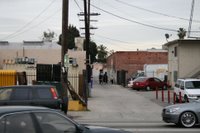 "Is it safe?"
"Is it safe?"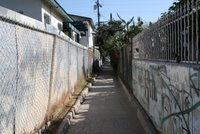 was 2,292,400. The population today is an estimated 3,844,829.
was 2,292,400. The population today is an estimated 3,844,829.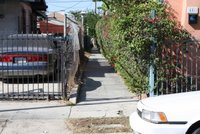 Wilshire and Vermont boulevards and will soon do so along Exposition; the residential population downtown has quadrupled linked with a dramatic service transformation; and, new school construction has re-purposed over a thousand acres.
Wilshire and Vermont boulevards and will soon do so along Exposition; the residential population downtown has quadrupled linked with a dramatic service transformation; and, new school construction has re-purposed over a thousand acres.Labels: Safety Dance
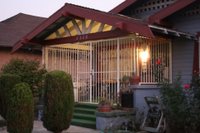 The spectator will often associate a preponderance of window bars and metal security fencing with unsafe conditions and high rates of crime. The pattern, as previously discussed in 30th ST Fortifications (12/3/06), is more complex. Metal security bars appear in upscale neighborhoods too, and remain in areas where crime has long ago decreased. In addition, ornamental wrought-iron grillwork was employed in many high style examples of the Spanish Revival (and some homeowners wish to emulate that feature).
The spectator will often associate a preponderance of window bars and metal security fencing with unsafe conditions and high rates of crime. The pattern, as previously discussed in 30th ST Fortifications (12/3/06), is more complex. Metal security bars appear in upscale neighborhoods too, and remain in areas where crime has long ago decreased. In addition, ornamental wrought-iron grillwork was employed in many high style examples of the Spanish Revival (and some homeowners wish to emulate that feature).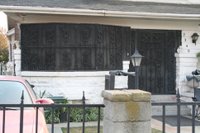 A few homeowners mark the transition to private space imperiously, with hacienda-like walls and nearly windowless facades. It allows an occupant to survey a visitor unseen, like the screened oriels of Islamic houses, or the semi-silvered glass of an interrogation room. Others not only bar but block windows with large pieces of furniture. Portals to the outside world are closed, covered with paneling, paper, or drywall. The house is made impregnable, and contact with the outside world is thoroughly moderated. Frequently, this is a sign of severe depression, agoraphobia, or other mental illness.
A few homeowners mark the transition to private space imperiously, with hacienda-like walls and nearly windowless facades. It allows an occupant to survey a visitor unseen, like the screened oriels of Islamic houses, or the semi-silvered glass of an interrogation room. Others not only bar but block windows with large pieces of furniture. Portals to the outside world are closed, covered with paneling, paper, or drywall. The house is made impregnable, and contact with the outside world is thoroughly moderated. Frequently, this is a sign of severe depression, agoraphobia, or other mental illness.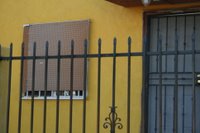 Here an additional skein of privacy is rendered by peg board.
Here an additional skein of privacy is rendered by peg board.Labels: Safety Dance
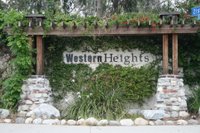 The neighborhood, that real estate morsel gets smaller and smaller, and often more rarefied, North of this, South of that, highlands, lowlands, canyon. Most every American metropolis brands itself a "city of neighborhoods, " often capitalizing on a nostalgia for smaller, so-called simpler places (and times). Sometimes a place name is nothing more than an organizational overlay, or the latest marketing come on; but in other places, the distinctions remain relevant and valuable.
The neighborhood, that real estate morsel gets smaller and smaller, and often more rarefied, North of this, South of that, highlands, lowlands, canyon. Most every American metropolis brands itself a "city of neighborhoods, " often capitalizing on a nostalgia for smaller, so-called simpler places (and times). Sometimes a place name is nothing more than an organizational overlay, or the latest marketing come on; but in other places, the distinctions remain relevant and valuable.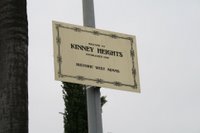 Faced with an urbanized realm of multiple, overlapping and often competing identities, boosters seek to assert uniqueness, emphasizing local amenities, topography, architecture, or ethnic concentration. Often though, identities and associations are imposed rather than elected, nasty proclamations, part imputation and allegation, race regard and raunch.
Faced with an urbanized realm of multiple, overlapping and often competing identities, boosters seek to assert uniqueness, emphasizing local amenities, topography, architecture, or ethnic concentration. Often though, identities and associations are imposed rather than elected, nasty proclamations, part imputation and allegation, race regard and raunch.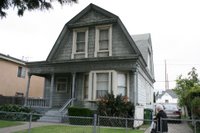 too. So have many other neighborhoods in parts of South and East Los Angeles. There's a few reasons why. One is the nature and extent of contact outsiders have with the community, residents, and amenities. For many, West Adams means USC or the Coliseum, and a brawl-riddled Raider game in 1987. A few have been to Exposition Park, or a car dealership on Figueroa. Seldom have outsiders probed the idyll of the West Adams Avenues or stately Wellington Square. Seldom had they reason to.
too. So have many other neighborhoods in parts of South and East Los Angeles. There's a few reasons why. One is the nature and extent of contact outsiders have with the community, residents, and amenities. For many, West Adams means USC or the Coliseum, and a brawl-riddled Raider game in 1987. A few have been to Exposition Park, or a car dealership on Figueroa. Seldom have outsiders probed the idyll of the West Adams Avenues or stately Wellington Square. Seldom had they reason to.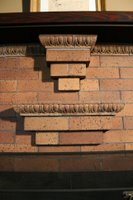 Sunday's Open
Sunday's OpenLabels: Safety Dance
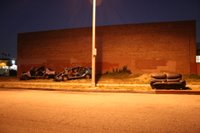 This series, a journal of my nightly non-adventures plying the reputedly, possibly, erroneously, tough streets of South Los Angeles, has become my most requested, contested, misunderstood, corroborated entry.
This series, a journal of my nightly non-adventures plying the reputedly, possibly, erroneously, tough streets of South Los Angeles, has become my most requested, contested, misunderstood, corroborated entry.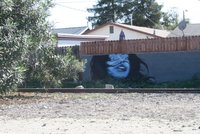 But my contention is, has been, continues to be, more bad shit is presumed to occur within these boundaries than actually occurs. West Adams and environs were never the city's toughest neighborhoods, others can/could claim that distinction, and to the extent they were ever tough--they've gotten less so.
But my contention is, has been, continues to be, more bad shit is presumed to occur within these boundaries than actually occurs. West Adams and environs were never the city's toughest neighborhoods, others can/could claim that distinction, and to the extent they were ever tough--they've gotten less so.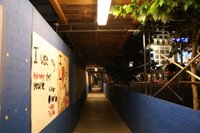 Then again, I looked at the numbers, those having to do with crime and USC. Since 1992 all colleges under the Jeanine Cleary Act have been required by federal law to compile and distribute annual statistics about crime on their campuses and remote facilities (including frat houses, residence halls, etc).
Then again, I looked at the numbers, those having to do with crime and USC. Since 1992 all colleges under the Jeanine Cleary Act have been required by federal law to compile and distribute annual statistics about crime on their campuses and remote facilities (including frat houses, residence halls, etc).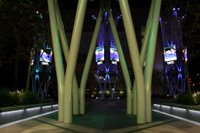 Perhaps I'm not stupidly ferocious, but of mean appearance, a leonine faced, early mid-lifer, passably athletic, bound for bald. Maybe the streets require some seasoning and a little spider sense. Maybe my vocation motivates my borough boosterism. Maybe it just ain't that bad out there, or at least only as bad--or as good--as everywhere else.
Perhaps I'm not stupidly ferocious, but of mean appearance, a leonine faced, early mid-lifer, passably athletic, bound for bald. Maybe the streets require some seasoning and a little spider sense. Maybe my vocation motivates my borough boosterism. Maybe it just ain't that bad out there, or at least only as bad--or as good--as everywhere else.Labels: Safety Dance
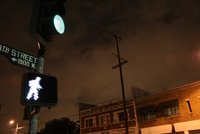
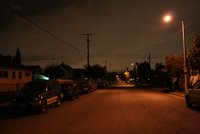 What's left for me to go on about? The big decrease in the South bureau, the uneventful details of my latest late night foray, peregrinating about Sugar Hill, Jefferson Park, Halldale and Adams-Normandie.
What's left for me to go on about? The big decrease in the South bureau, the uneventful details of my latest late night foray, peregrinating about Sugar Hill, Jefferson Park, Halldale and Adams-Normandie.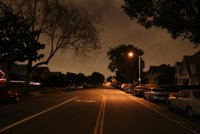 Still I stump, to fracture that association so prevalent, between the center and danger, the suburb and safety. Despite the revival of so many American cities, the re-popularization of New York City as lifestyle icon, and the European experience wherein affluence characterizes the old centers, Americans--Angelenos continue to bespatter their neighborhoods East and South. Bedroom communities most. The city's first suburbs in fact, simple subdivisions on relatively roomy lots, largely unencroached by industry or high use business districts, positively low density in places.
Still I stump, to fracture that association so prevalent, between the center and danger, the suburb and safety. Despite the revival of so many American cities, the re-popularization of New York City as lifestyle icon, and the European experience wherein affluence characterizes the old centers, Americans--Angelenos continue to bespatter their neighborhoods East and South. Bedroom communities most. The city's first suburbs in fact, simple subdivisions on relatively roomy lots, largely unencroached by industry or high use business districts, positively low density in places.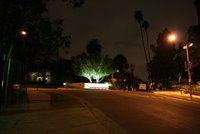 Certainly the population here (my beat) is multi-ethnic, with a pocket or two of physical squalor, and an absence of "hip joints". Those things matter to many, detract for some. But confuse the issues not, the statistics overwhelmingly suggest a relatively safe U.S. city, safer than most of us have ever known--and getting safer. Probably never safe enough for some. For those there's always Carstairs, Alberta, Culdesac, Idaho, or Catalina island.
Certainly the population here (my beat) is multi-ethnic, with a pocket or two of physical squalor, and an absence of "hip joints". Those things matter to many, detract for some. But confuse the issues not, the statistics overwhelmingly suggest a relatively safe U.S. city, safer than most of us have ever known--and getting safer. Probably never safe enough for some. For those there's always Carstairs, Alberta, Culdesac, Idaho, or Catalina island.Labels: Safety Dance
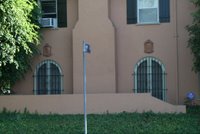 I'm asked constantly about the proliferation of security bars, doors, and fences in South Los Angeles. Ugly to be sure, and unneeded in most cases, though not confined to the 'hood. A block from Larchmont Village, at Windsor and first, windows bars can be noted in every direction (see photos). It's a Los Angeles pandemic, status for some, the fear peddler's calling card for others.
I'm asked constantly about the proliferation of security bars, doors, and fences in South Los Angeles. Ugly to be sure, and unneeded in most cases, though not confined to the 'hood. A block from Larchmont Village, at Windsor and first, windows bars can be noted in every direction (see photos). It's a Los Angeles pandemic, status for some, the fear peddler's calling card for others.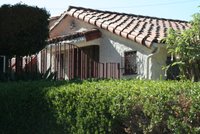 Of course nobody questions the safety of Larchmont Village, save the nescient LALife (which rated Hancock Park 1.5 on its safety scale of 1 to 10, ten being most safe). As determined by J-Park judico Michah Wright, the LALife site (previously lambasted here) does little more than overlay an entire district's reporting.
Of course nobody questions the safety of Larchmont Village, save the nescient LALife (which rated Hancock Park 1.5 on its safety scale of 1 to 10, ten being most safe). As determined by J-Park judico Michah Wright, the LALife site (previously lambasted here) does little more than overlay an entire district's reporting.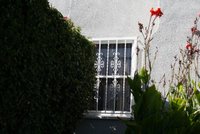 miles away, merely because they share the same patrols.
miles away, merely because they share the same patrols.Labels: Safety Dance
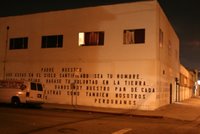 People often presume their current neighborhood to be safe, or more safe, than the place less known, and less white*. But try telling people that the neighborhood they live in is unsafe, it's like going after their gods, particulary if they're illusional Westsiders, living in the "burglary box" (Santa Monica to Federal, Santa Monica Blvd. to Wilshire), or some other supposed safe haven. When a home invasion happens in Beverly Hills, residents cup their ears, eyes, and mouth. "Unusual", they drone, "the exception." But when a kid gets cut near Vermont Knolls, the whip hand sounds and the righteous nod dismissively.
People often presume their current neighborhood to be safe, or more safe, than the place less known, and less white*. But try telling people that the neighborhood they live in is unsafe, it's like going after their gods, particulary if they're illusional Westsiders, living in the "burglary box" (Santa Monica to Federal, Santa Monica Blvd. to Wilshire), or some other supposed safe haven. When a home invasion happens in Beverly Hills, residents cup their ears, eyes, and mouth. "Unusual", they drone, "the exception." But when a kid gets cut near Vermont Knolls, the whip hand sounds and the righteous nod dismissively.Labels: Safety Dance
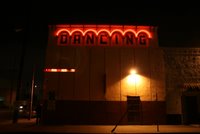
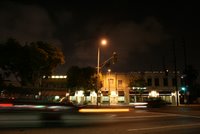 The City Living Realty offices sit at the crosshairs of Union, 24th, and Hoover. A current Volkswagen tv spot, showcases these marvelous Victorian Village facades. A sympathetic tow truck driver, opts not to abscond with an errantly parked Passat, and instead tows the objet du desir five feet forward, out a red zone.
The City Living Realty offices sit at the crosshairs of Union, 24th, and Hoover. A current Volkswagen tv spot, showcases these marvelous Victorian Village facades. A sympathetic tow truck driver, opts not to abscond with an errantly parked Passat, and instead tows the objet du desir five feet forward, out a red zone.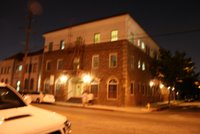 Continuing East along 23rd, we increasingly share the sidewalk with USC students or at least student aged youth, skateboarding, biking, wearing backpacks, engaged with their i-things. This brick apartment building has been recently and encouragingly restored. Once, when it was filthy and boarded up, I saw film schoolers shooting a WWII love story against its facade.
Continuing East along 23rd, we increasingly share the sidewalk with USC students or at least student aged youth, skateboarding, biking, wearing backpacks, engaged with their i-things. This brick apartment building has been recently and encouragingly restored. Once, when it was filthy and boarded up, I saw film schoolers shooting a WWII love story against its facade.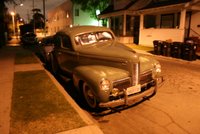 I seldom travel further East than Figueroa, not because of what lies beyond--the 110 freeway, warehouse districts, underappreciated East Adams--solely on account of distance. Time to arc West, beginning North on Toberman.
I seldom travel further East than Figueroa, not because of what lies beyond--the 110 freeway, warehouse districts, underappreciated East Adams--solely on account of distance. Time to arc West, beginning North on Toberman. The "West Adams" safety score, my prospective buyer bemoaned, was 0.5 on a scale of 0 to 10 (with 10 being best). Furthermore a thing called the LAlife crime index, which purported to measure violent crime, assigned a rating of 54 to the West Adams area, 200% higher than the LA County average. I was a bit taken aback, crestfallen really, and I considered any number of responses and sorry, partial refutations, anecdotal, statistical, the testimonials of others; until, I studied the LAlife
The "West Adams" safety score, my prospective buyer bemoaned, was 0.5 on a scale of 0 to 10 (with 10 being best). Furthermore a thing called the LAlife crime index, which purported to measure violent crime, assigned a rating of 54 to the West Adams area, 200% higher than the LA County average. I was a bit taken aback, crestfallen really, and I considered any number of responses and sorry, partial refutations, anecdotal, statistical, the testimonials of others; until, I studied the LAlife 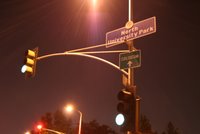 site again. The "West Adams" borders were completely misidentified, all wrong, utterly wrong, thoroughly wrong, and included much higher crime areas, adjacent to Baldwin Village for example.
site again. The "West Adams" borders were completely misidentified, all wrong, utterly wrong, thoroughly wrong, and included much higher crime areas, adjacent to Baldwin Village for example.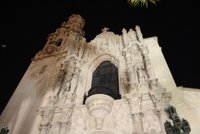 At any rate, I'm still out there walking, nearly every night, thus far with only happy incident, greetings from neighbors, short, friendly exchanges with other passers-by, and occasionally a good taco.
At any rate, I'm still out there walking, nearly every night, thus far with only happy incident, greetings from neighbors, short, friendly exchanges with other passers-by, and occasionally a good taco.Labels: Safety Dance
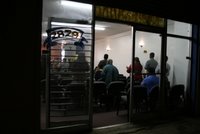
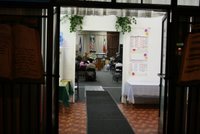 Two of the many storefront churches I encounter. In this corner of town, these venues are commanded almost entirely by Hispanic congregations, and are not necessarily limited to Catholic denominations. Some of these modest retail-built spaces formerly hosted African-american congregations.
Two of the many storefront churches I encounter. In this corner of town, these venues are commanded almost entirely by Hispanic congregations, and are not necessarily limited to Catholic denominations. Some of these modest retail-built spaces formerly hosted African-american congregations.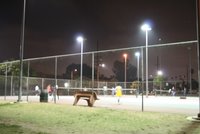 Looking for hot spots, we light out for Loren Miller Park. The only rowdies are playing soccer on a tennis court, basketball games are in full swing, and a man sells salted sugar cane. No one takes any notice of us.
Looking for hot spots, we light out for Loren Miller Park. The only rowdies are playing soccer on a tennis court, basketball games are in full swing, and a man sells salted sugar cane. No one takes any notice of us.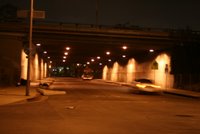
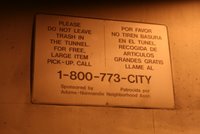 Angling through Adams-Normandie we confront the Budlong Tunnel, West Adams' most infamous dump site. Legend has it, Roland Souza furnished an entire house with Budlong Tunnel discards, including window treatments. Tonight it's quiet and only a few items have been left behind.
Angling through Adams-Normandie we confront the Budlong Tunnel, West Adams' most infamous dump site. Legend has it, Roland Souza furnished an entire house with Budlong Tunnel discards, including window treatments. Tonight it's quiet and only a few items have been left behind.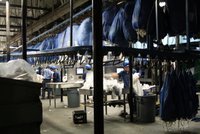 Elsewhere Washington Boulevard is still at work. Near the school-site, no the other school site, no the other school site, Allied Uniforms is busy. But not too busy to offer a tour.
Elsewhere Washington Boulevard is still at work. Near the school-site, no the other school site, no the other school site, Allied Uniforms is busy. But not too busy to offer a tour.Labels: Safety Dance
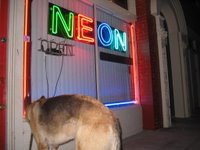 I like to walk about the city at night, generally with the shepherd, occasionally with friends.
I like to walk about the city at night, generally with the shepherd, occasionally with friends.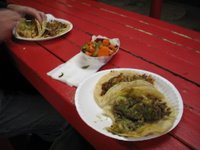
Labels: Safety Dance
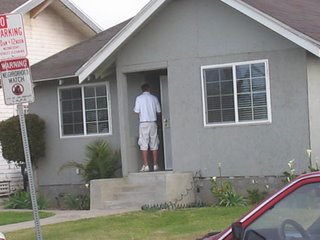
Labels: Safety Dance
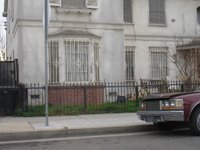
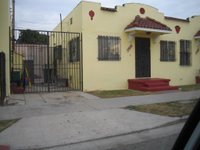
Labels: Safety Dance
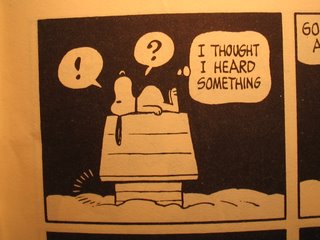
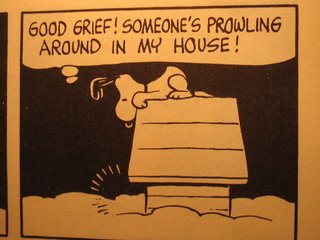
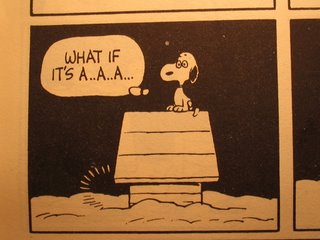
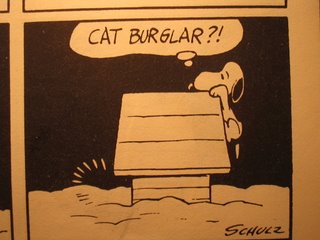
Labels: Safety Dance
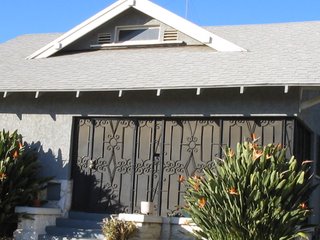
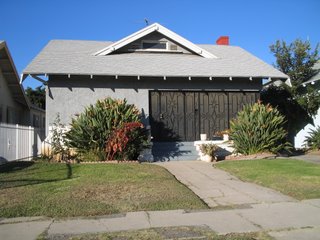
Labels: Safety Dance
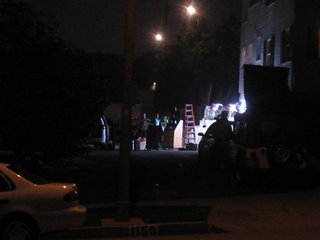
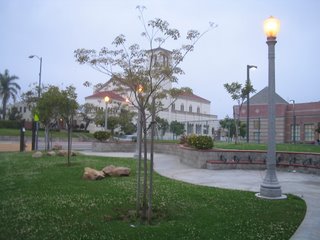
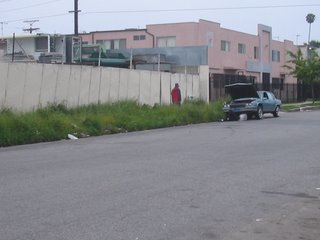
Labels: Safety Dance